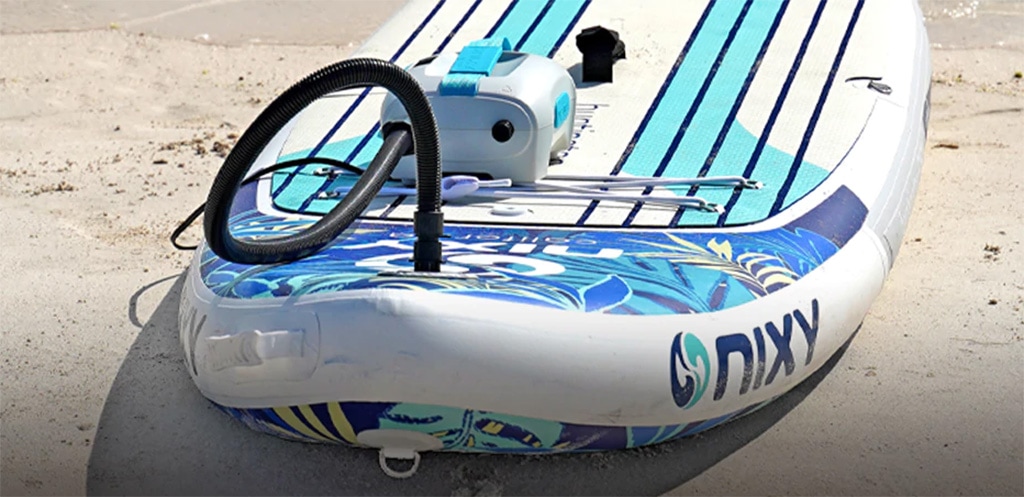Inflating a paddle board can be anxiety-inducing for the best of us! It’s important to inflate your board fully – but what happens if you over inflate your SUP?
While it is possible to over inflate your stand up paddle board, the good news is, most quality SUPs can handle the undue stress. Still, this doesn’t mean that it’s okay to overinflate your paddle board.
Today, I’m going to give you a little insight on what it means to overinflate your paddle board, why it’s important to understand, and how to keep from accidentally doing so.
RELATED: The 7 Best SUP Air Pumps to Prevent Overinflating Your Board
Too Much Air Pressure Can Damage Your Paddle Board
If the air pressure inside your board is too high, it can cause damage. Every inflatable paddle board comes with a recommended PSI level. PSI – or pounds (of force) per square inch – is the unit of measurement that relays how much air pressure an object can take on.
The average PSI for inflatable paddle boards ranges anywhere from 10 to 15 psi. However, some specialty paddle boards designed for specific use can take on a higher PSI — anywhere from 15 to 20. The maximum PSI for an inflatable SUP is 25 PSI.
It’s important to understand your paddle board’s pressure limits so that you don’t over inflate it. Paddle board manufacturers offer a PSI recommendation because this is the level at which you can expect the best performance from your inflated board.
Overinflation Can Cause Warping
An paddle board inflated to more than the recommended PSI can encounter problems.
As you inflate your paddle board, the inside air will become more compact and pressurized. If you over inflate the board, the extra air will look for somewhere to go. Most quality paddle boards are built really well and are able to take on an additional .5 – 1 PSI.
And while your board will be able to handle this extra pressure, it doesn’t mean it’s not going to hurt your board. Warping is a common issue caused by over inflation; parts of your board that offer a little more give may begin to warp under the extra pressure. This essentially means that the board will become bent out of shape.
Higher Pressure Can Damage to Your Paddle Board’s Seams
Naturally, if a stand up paddle board begins to warp, there’s unnecessary stress being put on the seams. As the pressurized air is looking for a way to escape, the seams are one of the first places where vulnerabilities may exist.
While it’s very unlikely that your paddle board will suddenly burst at the seams, you still don’t want this extra pressure putting stress on the board.
The pressurized air will look for a way to escape and it will do this by either pushing back against the pump or searching for a weakness in the material or the seams.
How to Avoid Overinflation
Now that you know what will happen if you overinflate your SUP, it’s a good idea to learn how to avoid it! Aside from adhering to the recommended PSI range, there are other things you can do (and avoid) to ensure that you inflate your board properly.
Don’t Use an Air Compressor
One of the most common questions amongst paddle boarders is whether or not you can inflate your board with an air compressor. While you technically can use an air compressor, this is a sure-fire way to unintentionally overinflate your SUP.
Air compressors are designed for heavy duty use like inflating a car tire. Unlike electric pumps designed for SUPs, an air compressor can push back against a PSI of 25 or more. If you’re inflating a board that has a limit of 15 psi, you can quickly and unintentionally cause your board to spring a leak or tear due to the excess pressure.
It’s also important to note that some paddle board brands strongly advise against using air compressors. In fact, some manufacturers state that if you use an air compressor, you automatically void your board’s warranty!
Use a Quality Electric SUP Pump
Using a quality SUP electric air pump is another great option to ensure your board is fully inflated without risking overinflation. Many electric SUP pumps have an automatic shut-off feature that keeps overinflation from occurring. Some quality built electric pumps also allow you to preset the PSI so that the pump will shut off automatically.
An electric SUP pump can be easier to use than a manual pump because it requires less work. However, electric pumps will need a source of power, whether it is your vehicle or a battery. Some SUP boards can be inflated with a manual pump, especially if the pump has a dual action system that helps to pressurize the air – but electric is generally easier.
Understand Your Boards PSI Range
The PSI recommendations are given as a ‘PSI range’. This gives some leeway, to account for other factors like heat, ambient temperature in the environment or your own personal preference for how stiff you want the board to be. Heavier riders might want more stiffness, for example, so it makes sense to inflate to high pressures (without exceeding the range, of course).
While it might make your paddle board stiffer – exceeding the recommended PSI range is not worth it. It offers no real practical benefits, and makes little difference to the performance of the board in the grand scheme of things. If you want a more rigid SUP, it’s better to buy a different model – rather than risk over inflating the one you have.
Utilize Your PSI Gauge
The best type of paddle board pumps feature a PSI gauge on them. The PSI gauge gives you insight into the pressure per square inch inside your paddle board.
If you have too much air, you know to lay off a little as you pump. On the other hand, having a low reading allows you to continue inflating to make your board as rigid as it needs to be for best paddling performance, without worrying that you’re going to overinflate the paddle board.
Conclusion
It’s not uncommon to unintentionally over inflate your SUP. The good news is, many quality SUPs can handle over inflation by 1 or 2 PSI over the recommended limit. Most quality inflatable stand up paddle boards are specially designed to handle such things – so as long as you stay within the recommended range, you should be fine.
If you do go over, this can cause damage to the material and structure of your SUP board. Plus, if there are any changes in temperature (for example you leave the SUP board in the sun) then bulging (or even bursting) could occur.
Better to understand your SUP board and it’s PSI, use a pump with a gauge, and only inflate to a point where the pressure is resting comfortably within the recommended range.


